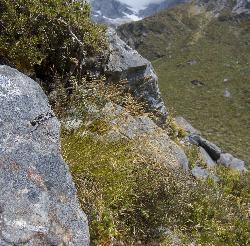- Taxon
- Gallery
- ≡ Danthonia semiannularis var. setifolia Hook.f., Bot. Antarct. Voy. II. (Fl. Nov.-Zel.) Part I, 304 (1853)
- ≡ Danthonia setifolia (Hook.f.) Cockayne (1921)
- ≡ Notodanthonia setifolia (Hook.f.) Zotov, New Zealand J. Bot. 1: 108 (1963)
- = Danthonia semiannularis var. alpina Buchanan, Indig. Grasses of N. Z. t. 34 (2) A (1879)
Stiff, yellow-green or bright green tussocks, often with tufts of leaves at ends of elongating shoots, rooting at nodes; leaves semi-pungent, ≤ culms (occasionally very much shorter), disarticulating at ligule; branching intravaginal. Leaf-sheath pale stramineous, glabrous; apical tuft of hairs (0.2)–1.0–3.0 mm. Ligule 0.2–0.8 mm. Leaf-blade to 25–(35) cm, stiff, inrolled, rounded, glabrous, margins glabrous. Culm to 50 cm, internodes glabrous. Panicle ± erect, to 6 cm, of few large spikelets on very slender pedicels; rachis and pedicels almost glabrous or with a few scattered prickle-teeth usually along edges and below spikelets, a few long hairs at branch axils. Spikelets (3)–4–6-flowered, awns exserted from glumes. Glumes becoming light red-purple to purple-black centrally, lanceolate, subobtuse to acute, (5.5)–7–11–(20) mm, ± equal; lower 3–5-nerved, upper (3)–5–(7)-nerved. Lemma (2)–2.5–3.5–(4) mm, 7–9-nerved, upper and lower rows of hairs continuous, upper row slightly < lemma lobes, lower row usually reaching to base of upper row, glabrous elsewhere but occasional hairs centrally, margins often hair-fringed; lobes (2.3)–3–4–(5) mm, tapering to short fine awn; central awn 8–12 mm, widely divergent, column 1–2 mm usually < upper lemma hairs. Palea 3–5 mm, ≥ upper lemma hairs, interkeel glabrous or occasional scattered short hairs, margins with long hairs below or glabrous. Callus c. 0.5 mm, short marginal hair tufts overlapping lower lemma hairs. Rachilla 0.6–1 mm, occasionally crowned with minute hairs. Anthers (1.2)–1.5–3 mm. Caryopsis 1.1–1.5 × 0.6–0.7 mm; embryo 0.5–0.8 mm; hilum 0.2–0.3 mm. 2n= 24. Plates 6A, 11E.
[From: Edgar and Connor (2000) Flora of New Zealand. Volume 5 (second printing).]




